Related Research Articles

Datura is a genus of nine species of highly poisonous, vespertine-flowering plants belonging to the nightshade family (Solanaceae). They are commonly known as thornapples or jimsonweeds, but are also known as devil's trumpets. Other English common names include moonflower, devil's weed, and hell's bells. All species of Datura are extremely poisonous and potentially psychoactive, especially their seeds and flowers, which can cause respiratory depression, arrhythmias, fever, delirium, hallucinations, anticholinergic syndrome, psychosis, and even death if taken internally.
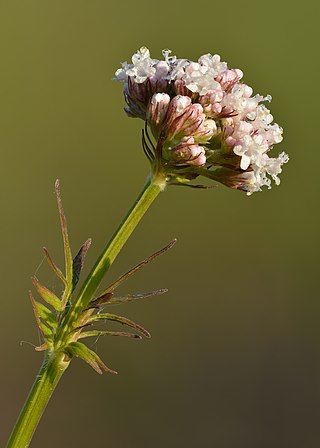
Valerian is a perennial flowering plant native to Europe and Asia. In the summer when the mature plant may have a height of 1.5 metres, it bears sweetly scented pink or white flowers that attract many fly species, especially hoverflies of the genus Eristalis. It is consumed as food by the larvae of some Lepidoptera species, including the grey pug.

In polymer chemistry and materials science, a resin is a solid or highly viscous substance of plant or synthetic origin that is typically convertible into polymers. Resins are usually mixtures of organic compounds. This article focuses mainly on naturally occurring resins.

Asafoetida is the dried latex exuded from the rhizome or tap root of several species of Ferula, perennial herbs of the carrot family. It is produced in Iran, Afghanistan, Central Asia, northern South Asia, and Northwest China (Xinjiang). Different regions have different botanical sources.
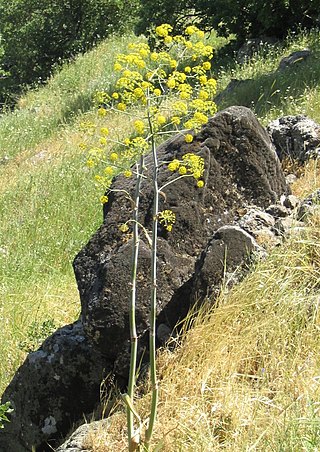
Ferula is a genus of about 220 species of flowering plants in the family Apiaceae, native to the Mediterranean region east to central Asia, mostly growing in arid climates. They are herbaceous perennial plants growing to 1–4 m tall, with stout, hollow, somewhat succulent stems. The leaves are tripinnate or even more finely divided, with a stout basal sheath clasping the stem. The flowers are usually yellow, rarely white, produced in large umbels. Many plants of this genus, especially F. communis, are referred to as "giant fennel," although they are not fennel in the strict sense.

Orris root is the root of Iris germanica and Iris pallida. It had the common name of Queen Elizabeth Root.

Agarwood, aloeswood, eaglewood or gharuwood is a fragrant dark resinous wood used in incense, perfume, and small carvings. This resinous wood is most commonly referred to as oud or oudh. It is formed in the heartwood of Aquilaria trees when they become infected with a type of mold and secrete a resin to combat the mold. Prior to infection, the heartwood is odourless, relatively light and pale coloured; however, as the infection progresses, the tree produces a dark aromatic resin, called aloes or agar as well as gaharu, jinko, oud, or oodhaguru, in response to the attack, which results in a very dense, dark, resin-embedded heartwood. The resin-embedded wood is valued in East and South Asian cultures for its distinctive fragrance, and thus is used for incense and perfumes.

Benzoin or benjamin is a balsamic resin obtained from the bark of several species of trees in the genus Styrax. It is used in perfumes and some kinds of incense and as a flavoring and medicine. It is distinct from the chemical compound benzoin, which is ultimately derived chemically from benzoin resin; the primary active ingredient of benzoin resin is actually benzoic acid not benzoin.

Aconitum ferox is a member of the monkshood genus Aconitum of the Ranunculaceae. The common name by which it is most often known in English is Indian Aconite, while the Hindi names used by practitioners of Ayurveda include वत्सनाभvatsanabha and महाविषाmahavisha.
Ammoniacum or the gumammoniac is a gum-resin exuded from the several perennial herbs in the genus Ferula of the umbel family (Apiaceae). There are three types of ammoniacum: the gums ammoniac of Cyrenaica, of Persia, and of Morocco.

Galbanum is an aromatic gum resin and a product of certain umbelliferous Persian plant species in the genus Ferula, chiefly Ferula gummosa and Ferula rubricaulis. Galbanum-yielding plants grow plentifully on the slopes of the mountain ranges of northern Iran. It occurs usually in hard or soft, irregular, more or less translucent and shining lumps, or occasionally in separate tears, of a light-brown, yellowish or greenish-yellow colour. Galbanum has a disagreeable, bitter taste, a peculiar, a somewhat musky odour, and an intense green scent. With a specific gravity of 1.212, it contains about 8% terpenes; about 65% of a resin which contains sulfur; about 20% gum; and a very small quantity of the colorless crystalline substance umbelliferone. It also contains α-pinene, β-pinene, limonene, cadinene, 3-carene, and ocimene.
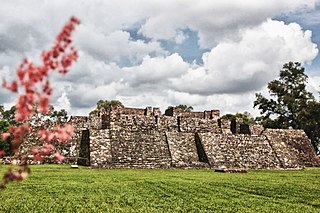
The ancient Aztecs employed a variety of entheogenic plants and animals within their society. The various species have been identified through their depiction on murals, vases, and other objects.
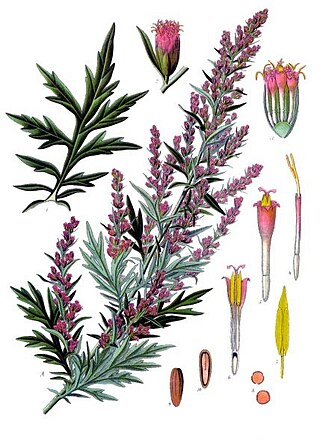
Mugwort or biboz is a common name for several species of aromatic flowering plants in the genus Artemisia. In Europe, mugwort most often refers to the species Artemisia vulgaris, or common mugwort. In East Asia the species Artemisia argyi is often called "Chinese mugwort" in the context of traditional Chinese medicine, Ngai Chou in Cantonese or àicǎo (艾草) in Mandarin. Artemisia princeps is a mugwort known in Korea as ssuk (쑥) and in Japan as yomogi (ヨモギ). While other species are sometimes referred to by more specific common names, they may be called simply "mugwort" in many contexts.

Eriocephalus is a genus of African flowering plants in the daisy family.

Alstonia constricta, commonly known as quinine bush or bitterbark, is an endemic Australian endemic shrub or small tree of the family Apocynaceae.
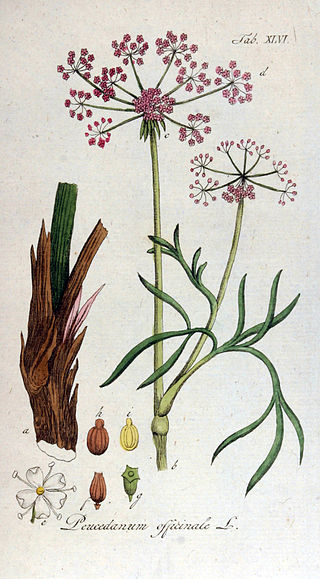
Peucedanum officinale is a herbaceous perennial plant in the family Apiaceae found mainly in Central Europe and Southern Europe. It is also native to the UK, where it has the common names hog's fennel and sulphurweed, but it is a rare plant there, occurring only in certain localities in the counties of Essex and Kent. It was formerly also found near the town of Shoreham-by-Sea in the county of West Sussex, but has long been extinct there.

Ligusticopsis wallichiana is a species of flowering plant in the family Apiaceae. In cultivation, it has been known by the synonym Selinum wallichianum.

Mostuea is one of only three genera of flowering plants belonging to the small family Gelsemiaceae. Mostuea and Gelsemium were formerly placed in the family Loganiaceae, while Pteleocarpa was placed variously in the families Icacinaceae, Cardiopteridaceae, Boraginaceae, and others, before the description of the Gelsemiaceae was altered formally to accommodate it in 2014. Mostuea is native to Africa and South America. Anecdotal evidence suggests that the roots of certain Mostuea species are used as ritual aphrodisiacs and entheogens in West Tropical Africa.

Ferula moschata, the musk root or sumbul, is a species of flowering plant in the family Apiaceae, found from Central Asia to western Xinjiang. Its roots are the source of muskroot, a substitute for animal musk in medicinal and perfumery applications.
References
- ↑ Page Ferula sumbul in The Plant List http://www.theplantlist.org/tpl1.1/record/kew-2808672 Retrieved 12.53 19/9/17
- ↑ Schultes, Richard Evans; Hofmann, Albert (1979). The Botany and Chemistry of Hallucinogens (2nd ed.). Springfield Illinois: Charles C. Thomas ISBN 0-398-03863-5 Pages 368 (plant list) and 378 (bibliography).
- ↑ Grieve, Mrs. M. A Modern Herbal , first published 1931,Jonathan Cape Ltd.,reprinted 1974 and 1975. pps. 781-2.
- ↑ Quattrocchi, Umberto (2012). CRC World dictionary of medicinal and poisonous plants: common names, scientific names, eponyms, synonyms and etymology. Volume 5 R-Z. CRC Press Taylor and Francis Group. pps. 228-9.
- ↑ Reduron, J-P Notes on the Umbelliferae of France, with special reference to poorly known taxa South African Journal of Botany 2004, 70(3): 449–457.
- This article incorporates text from a publication now in the public domain : Chisholm, Hugh, ed. (1911). "Sumbul". Encyclopædia Britannica . Vol. 26 (11th ed.). Cambridge University Press. p. 75.